Table of Contents
The San Juan Mountains of Western Colorado are often referred to as the “Switzerland of America.” Among the many mining properties in this area is the well-known Camp Bird mine. The history of this property dates to 1877 although its really active beginning was on May 12, 1902 when Camp Bird Limited, an English company, commenced production and operated it until 1916. Production during this period is estimated at $41,000,000, primarily in gold and silver values.
In 1926 Camp Bird Limited leased the property to King Leases, Inc. In addition to the gold and silver values, increased quantities of lead were recovered, and in 1942 the mill was redesigned to recover zinc as a separate concentrate. This operation ceased in 1956 when Camp Bird Limited decided to operate the property in its own right.
Extensive work coupled with a thorough understanding of the geological features indicated the existence of significant ore reserves. Production was resumed towards the end of 1960 through Camp Bird Colorado, Inc., a wholly owned subsidiary of Camp Bird Mining, Ltd. of London, England. A new mill having a capacity of 500 tons of crude ore per day was built at the same site as the old mill. This marked a new era for the famous Camp Bird mine.
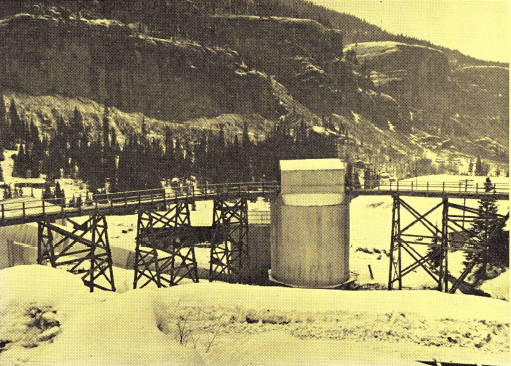
Water and Power
Abundant water is available for milling purposes. The heavy snowfall and natural streams provide virtually unlimited water for milling requirements. Mine water is also available and is not detrimental to the milling process.
As ore arrives at the mill it is dumped directly from ore cars into a 500-ton steel coarse ore bin shown in center.
Public power is supplied by the Western Colorado Power company. Standby generators are not required due to the dependability of the local power supply. The mine office has telephone service.
Geology
The country rock in which the various veins are situated is wholly of volcanic origin above the main tunnel level. Diamond drill hole intercepts have established the location of the top beds of the sedimentary series underlying the volcanics to be some 400 feet below main tunnel level. The formations are briefly as follows:
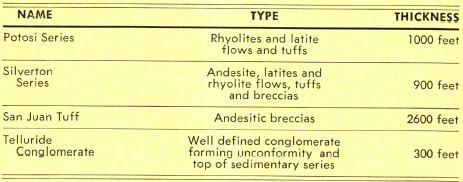
Within the property owned by Camp Bird occur three recognized fracture systems. Of these one strikes northwest and dips steeply northeast, another strikes northwest and dips steeply southwest, whilst the Camp Bird vein, the only known representative of the third system, strikes almost due east and dips steeply to the south. All of the major veins of the area are well known for their persistence in strike length and depth.
With regard to past operations in the Camp Bird property, these have all been confined essentially to oreshoots situated within the Camp Bird vein and which has been a prolific producer of gold in its earlier production phase and subsequently precious metals in combination with lead, copper and zinc sulfides. Investigation of the other veins within the property has indicated the existence of considerable tonnages of economic millfeed. Geological inferences coupled with recent developments also indicate that previously uninvestigated areas within the Camp Bird vein itself might well contain additional oreshoots which, by virtue of previous mining practice or because of the metal type being sought, were ignored or overlooked. A planned program to develop and exploit the potential of these untapped sources of millfeed is in effect.
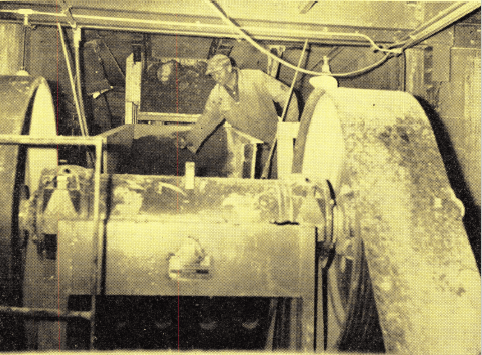
A 21″ x 36″ Jaw Crusher reduces mine-run ore to—3″. Crusher product is then screened at ¾”.
Test Work
The mill flowsheet and general operating conditions were established by the Ore Testing Division of Equipment Company. The results of locked cycle batch tests were readily confirmed in the operating plant without any significant change in the reagent combination, grind, or mill flowsheet. This installation effectively illustrates the importance of proper test work and the intelligent interpretation of test data as a primary requisite in mill design and overall planning.
Mill Construction
The mill was designed and constructed by Western Knapp Engineering Company of San Francisco, Calif., under the direction of Robert Raring and Harry McNeil. All work was carefully coordinated with Camp Bird engineers. A large proportion of the equipment selected for the mill was supplied by the Equipment Company.
Design and construction details were carefully planned for a six months building season to avoid the heavy winter snows. Construction started on May 15, 1960, and was completed on schedule in October, 1960.
Equipment Company wishes to thank Western Knapp Engineering Company for the use of certain photographs that materially help in presenting a picture of this outstanding mill.
Mining
All mining is conducted from a main adit some 11,500 feet long. The ore is mined by shrinkage stoping systems in which the ore is dropped to the main haulage through ore passes. Haulage is in Granby – type cars pulled by electric trolley locomotives. The coarse ore bin is located at the same elevation as the main haulage adit so the cars dump directly into the coarse ore bin of the mill.
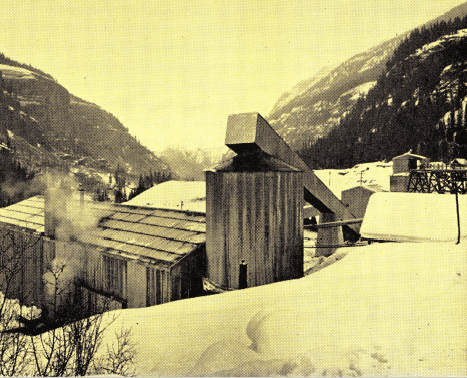
Secondary crusher product joins the —¾” screen undersize and is conveyed to 500-ton welded steel fine ore bin.
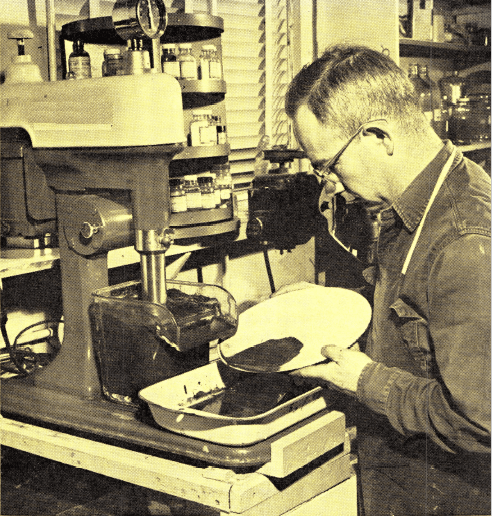
Camp Bird Colorado, Inc., selected the Process Testing Division to develop flowsheet and metallurgical recommendations. Test Engineer H. C. Hurd, Jr., is shown conducting a locked-cycle batch flotation test on Camp Bird ore.
Crushing
The crushing plant consists of two stage reduction and is operated on a one shift per day basis. The crude ore is wet and sticky and required initial design considerations in the crushing plant. The reciprocating type feeder, overhead eccentric-type jaw crusher, and oversize vibrating screen were selected to alleviate the problems in handling this type of ore. All chutes and transfer points were set at a maximum slope to minimize sticking.
The mine ore is dumped directly from the ore cars into a 500-ton steel cylindrical coarse ore bin through an 8″ grizzly. The ore is discharged using a 30″ x 8′ Reciprocating Plate Feeder that delivers the ore to a vibrating grizzly and to a 21″ x 36″ Jaw Crusher with overhead type eccentric. The grizzly undersize and crusher discharge products are combined and conveyed by two stages of 24″ belt conveyors to a single deck vibrating screen. The first conveyor is 75′ long and is set at a 12° slope. An electromagnet is located above the head pulley of the first conveyor to remove tramp iron. The second conveyor is set at a slope of 16° and is 65′ long. Both of these conveyors travel at a speed of 210 feet per minute.
The 5′ x 10′ vibrating screen receives the ore from the second belt conveyor and produces an oversize that feeds into a 36 S Telsmith Cone Crusher. The vibrating screen is equipped with a ½” x 5″ screen cloth. The slotted type screen cloth was found to be necessary to prevent blinding of the screen. The screen cloth life is approximately six weeks. The screen undersize and cone crusher discharge products are conveyed to a 500- ton fine ore bin using a 24″ x 196′ belt conveyor moving at a speed of 200 feet per minute and set at a 17° slope.
Grinding
The fine ore storage consists of a 500-ton welded steel cylindrical bin located outside the main mill building. The fine ore (minus ¾ inch) is discharged from the bin using a 24″ Pioche – type belt feeder equipped with a variable speed drive. The feeder discharges to a conveyor that feeds the two-stage grinding circuit. A belt weighing device is incorporated in the conveyor to record the feed rate. The two-stage grinding circuit consists of a 5′ x 10′ Rod Mill and a 7′ x 6′-6″ Ball Mill. The rod mill is operated in one circuit. Head sample is taken by a Automatic Sampler on the rod mill discharge which flows to a 5″ x 4″ SRL-C Pump feeding a 15″ Krebs Cyclone. The cyclone overflow is controlled at 60% minus 200 mesh and is fed directly to flotation. The cyclone underflow (about 10 mesh) flows to the ball mill which operates in closed circuit with the pump- cyclone installation. The pump is protected from tramp oversize by ¼” spiral screens on the rod and ball mill discharges.
Block-type chrome-moly shell liners and manganese steel head liners are used in the rod mill. The ball mill is equipped with double wave chrome-moly liners. Liner life on the rod mill was approximately 110,000 tons and 115,000 tons on the ball mill. Comparative tests will be made using manganese steel shell liners.

The ball and rod mills are of the trunnion overflow type. The cyclone inlet pressure is regulated at approximately 5 psi.
Flotation
As will be noted in Table 1, the lead concentrate contains a significant quantity of copper. The initial mill design included consideration of this fact and space was provided for the ultimate installation of a lead- copper separation circuit. Tests are now in progress to study this separation and plans are being made to install a reflotation circuit to separate the copper from the lead. Increased mill returns are expected from this contemplated separation.
The ore is a very complex sulphide requiring a high degree of selectivity in the flotation process.
The flotation section consists of two 10-cell No. 24 (43×43) “Sub-A” Flotation Machines, one bank for lead and the other for zinc. Dual cell drives
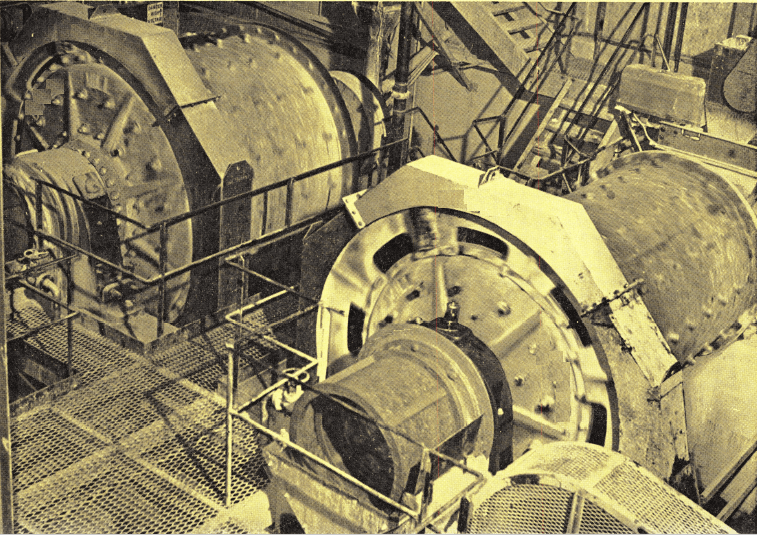
The modern design of both the Camp Bird Colorado, Inc., mill and equipment is typified by this photo of the 5′ x 10′ Rod Mill which operates in open circuit. Rod mill discharge is pumped by a 5″ x 4″ SRL-C Pump to a cyclone classifier. The cyclone oversize feeds the 7′ x 6′-6″ Ball Mill which operates in closed circuit with this classifier to the ball mill for re-grinding. Cyclone overflow is ready for lead flotation without conditioning. Both Mills have steel heads and tramp oversize is removed from mill discharge by means of Spiral Screens.
are provided with 15 HP motors driving two cells. The launder arrangement and pulp flow is the same for both machines and provides double cleaning of the rougher concentrates. The feed in both instances enters the number 3 cells and flows successively from one cell to another until discharged from the number 10 cell. The froth (scavenger) from the last two cells is returned to the number 4 cell and the rougher froth from cells 4 to 8, inclusive enters the number 2 cell. The cleaned froth from the number 2 and 3 cells is recleaned in the number 1 cell to constitute the final flotation concentrate. This intricate arrangement of pulp flows is accomplished without the use of pumps and is possible with the distinctive cell-to-cell design of the “Sub-A” Flotation Machine.
No conditioning is required ahead of the lead flotation bank. The lead tailing, however, is conditioned in an 8′ x 8′ Conditioner before zinc flotation. Refer to Table II for the reagent combination and points of addition.
The flotation machines are equipped with multi-bladed moulded rubber impellers. The direction of rotation is reversed periodically in order to increase wearing life. The rougher and scavenger cells are supercharged with low pressure air. The cleaner cells are operated on atmospheric air. All cells are single overflow and equipped with froth paddles.
The floor beneath the flotation machines is divided into two areas to isolate any spills in the lead and zinc sections. Each area is provided with a 1½” sump pump which returns the accumulated solids to their respective flotation circuits.
The recleaned flotation concentrates are sampled with Automatic Samplers and then pumped to the thickeners using 1½” Vertical Sand Pumps. The crushers and grinding mills are serviced by hand operated bridge cranes, while the flotation section is equipped with a monorail.
Reagents
The flotation reagents, as shown in Table II, are more or less conventional for selective flotation of lead and zinc sulfides except no alkalinity control reagent is added to the lead circuit. The ore produces a pulp having a natural pH of 8.0 which is suitable for the selective flotation of the lead and copper minerals. The pulp is well dispersed due to inherent characteristics of the ore. All reagent solutions are fed with cup-type feeders. The lime is fed with vibrating feeders. Thiocarbanilide is added to the rod mill using a Dry Cone Feeder.
Frequent changes are made in the reagent combination to explore all possibilities relating to maximum metallurgical efficiency at minimum cost.
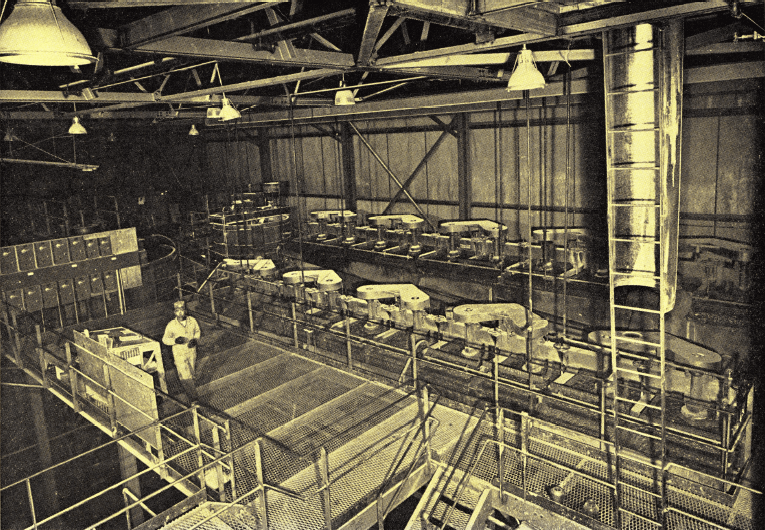
“Sub-A” Flotation is used by Camp Bird Colorado, Inc., for roughing, scavenging, cleaning and recleaning in both the lead circuit and the zinc circuit. In the photo below, the lead cells are at the rear and the zinc cells are in the foreground. A lead-copper concentrate containing gold and silver is obtained in the 10-cell “Sub-A” Flotation Machine. Five cells are for roughing, two cells are scavengers and the rougher concentrate is cleaned and recleaned. Lead flotation tailings are conditioned prior to zinc flotation.
Thickening and Filtering
The lead concentrate is thickened in a 15′ x 8′ Thickener. The underflow is delivered to a 6′ diameter x 2-Disc Filter by means of a 4″ Simplex Diaphragm Pump. The filter cloth is cotton duck and has a life of about 30 days. The moisture content of the filter cake averages 8.0 percent. The zinc concentrate after thickening in a 22′ x 10′ Thickener is pumped to a 6′ diameter x 3-Disc Filter. Polyethylene is presently used as the filter media. The filtered zinc concentrate contains approximately 10.0 percent moisture.
Lime is used as a flocculant in the thickeners. The overflows from both concentrate thickeners are combined and added to the mill tailing ahead of the tailing sampler. The filtrates are returned to their respective thickeners. No reuse of water is made in the plant due to the abundance of water available for milling.
The filter cakes drop by gravity to ground level storage areas. Concentrate bins were eliminated to avoid possible freezing during the long cold winters. The stored concentrates are loaded into 15-ton trucks using a front end loader, and hauled 16 miles to Ridgway, Colo., in the case of lead and 41 miles to Montrose, Colo., for zinc. At these points the concentrates are transferred to the railroad and shipped to the smelters. The lead-copper concentrate is shipped to El Paso, Tex., and the zinc concentrate to Amarillo, Tex., where they are purchased under contract by the American Smelting and Refining Company.
Sampling
All sampling is done wet using Automatic Samplers having a 21″ cut. The mill head sample is taken on the rod mill discharge. The cutting interval, which is the same for all samplers in the mill, is 20 minutes.
The concentrate samplers consist of two parallel cutters attached to the carriage. One cutter provides a shift sample and the other a 24-hour sample. These sample cuts flow by gravity to separate 12″ diameter x 3″ Laboratory Pan Filters which dewater the concentrates and act as the sample container.
A portion of the zinc concentrate is fed by gravity to a laboratory size concentrating table which enables the operator to visually examine the concentrate at all times.
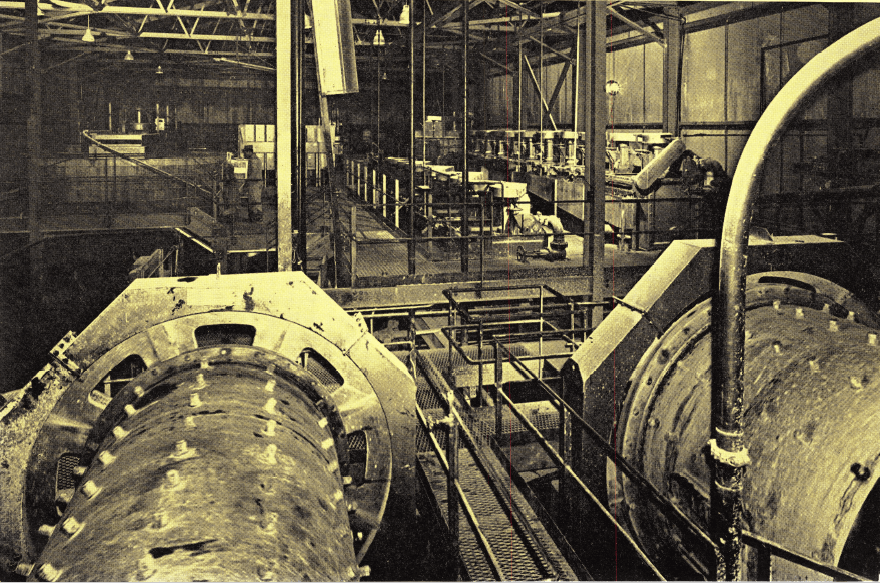
This view of the Camp Bird Colorado, Inc., mill overlooks the grinding circuit. “Sub-A” Flotation Machines at the far right produce the concentrates which are dewatered in Spiral Rake Thickeners and Disc Filters. Filter cake drops by gravity to ground-level storage area. A unique sampling arrangement is employed at this mill. As the flotation concentrates flow to their pump they are cut with a Automatic Sampler which has two parallel cutters. One cutter provides a shift sample while the other sample is the 24-hour sample. As the samples are cut each is discharged to its own 12″ x 3″ Laboratory Pan Filter which provides a dewatered sample ready for analysis.
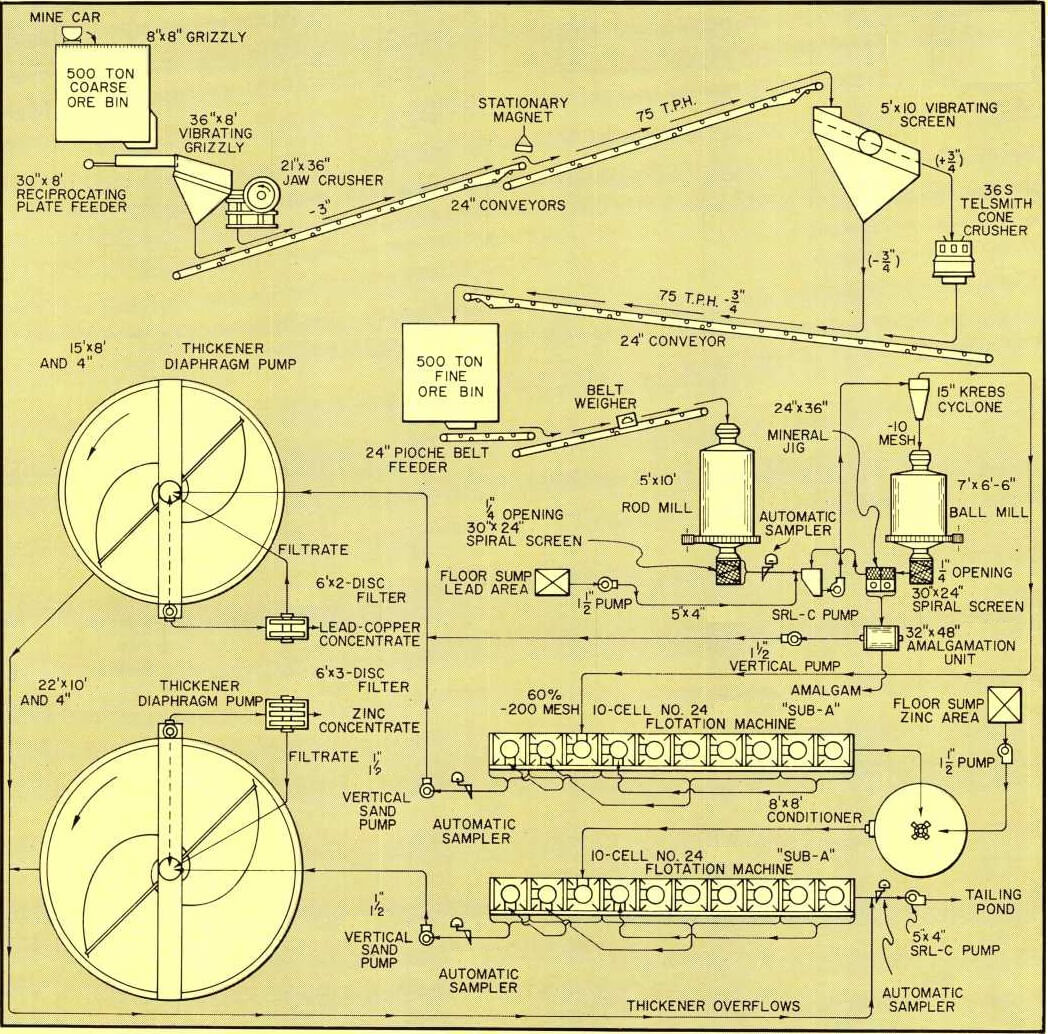
Flowsheet for Camp Bird Colorado, Inc., was developed from data supplied by comprehensive tests conducted at the Process Testing Division. The results of locked-cycle batch tests were readily confirmed in the operating plant without any significant change in the reagent combinations, grind or flowsheet. Mill designers were able to take full advantage of the interpretation of reliable test data. The result is a mill capable of efficient and continuous operation.
Tailing Disposal
The mill tailing after being sampled by a Automatic Sampler is pumped approximately 1500 feet by a 5″ x 4″ SRL-C Pump to the tailing pond. The tailings are pumped through a 4″ plastic pipe line at 25% solids to a 15″ Krebs Cyclone which is mounted on a truck for portability. The cyclone underflow is used for building the face of the dam and the overflow is discharged to the center of the pond. The cyclone is periodically moved along the top of the dam.
Laboratory
In addition to sample preparation equipment, the mill laboratory is equipped with a 1000-gram “Sub-A” Laboratory Flotation Cell. This machine is used for investigating reagent changes and for general flotation testing.
The assay laboratory is fully equipped for the determination of the elements contained in the Camp Bird ore. Mine samples and mill products are assayed in this laboratory.
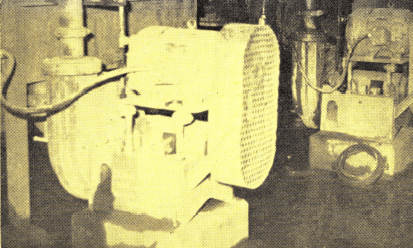
SRL Pumps are used for abrasive service. This 5″ x 4″ SRL-C Pump is on cyclone feed service, handling —¼” rod mill discharge at 66% solids to provide cyclone inlet pressure of 5 p.s.i.
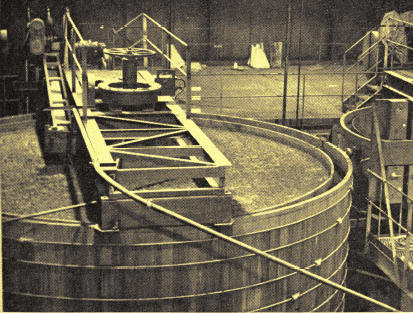
Two Spiral Rake Thickeners are in service at the Camp Bird Mill. This 22′ x 10′ thickener handles the zinc flotation concentrates. A 4″ Simplex Adjustable Stroke Diaphragm Pump meters thickener underflow to a 6′ x 3-disc Filter. Lead-copper flotation concentrate is thickened in a 15′ x 8′ Thickener.
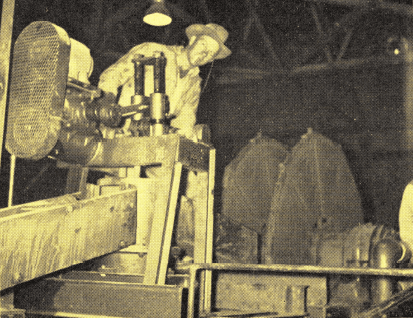
Camp Bird Colorado, Inc., selected two Disc Filters for their mill. A 6′ x 2-disc Filter handles the lead- copper concentrates while a 6′ x 3-disc Filter handles zinc concentrates. A 4″ Simplex Adjustable Stroke Diaphragm Pump in foreground is being checked by operator.
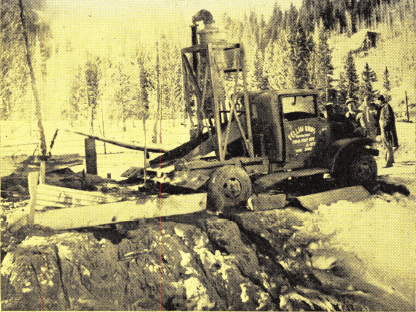
The portability of a truck mounted cyclone classifier makes possible the building of a tailings dam using the cyclone underflow while the cyclone overflow is discharged to the center of the pond.
Conclusion
This operation exemplifies the importance of today’s geological, mining, and processing methods. The Camp Bird staff is to be congratulated for their fortitude and progressive planning in resuming operations at this famous property.


